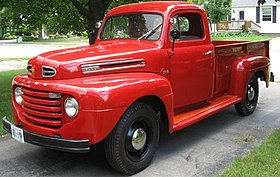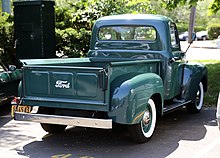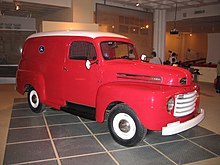Ford F-Series (first generation)
This article relies largely or entirely on a single source. (March 2014) |
This article needs additional citations for verification. (March 2014) |
| First generation | |
|---|---|
 1950 Ford F-3 | |
| Overview | |
| Manufacturer | Ford |
| Also called | Ford Bonus-Built |
| Production | November 27, 1947–1952[1] |
| Model years | 1948–1952 |
| Assembly | Chester, Pennsylvania, USA Dearborn, Michigan, USA Edison, New Jersey, USA Long Beach, California, USA Norfolk , Virginia St. Paul, Minnesota St. Louis, Missouri, USA Hapeville, Georgia, USA Highland Park, Michigan, USA |
| Body and chassis | |
| Class | Full-size pickup truck |
| Body style | 2-door pickup 4-door panel truck |
| Layout | Front engine, rear-wheel drive / four-wheel drive |
| Related | 1946 Mercury M-Series |
| Powertrain | |
| Engine | 226 cu in (3.7 L) I6 239 cu in (3.9 L) Flathead V8 254 cu in (4.2 L) I6 337 cu in (5.5 L) Flathead V8 215 cu in (3.5 L) I6 279 cu in (4.6 L) Y-block V8 317 cu in (5.2 L) Y-block V8 |
| Transmission | 3-speed manual 4-speed manual 5-speed manual |
| Chronology | |
| Predecessor | 1941-1947 Ford pickup |
| Successor | Ford F-Series second generation (1953–1956) |


The first-generation Ford F-Series is a series of pickup trucks and commercial vehicles produced by Ford. Introduced in 1947, the F-Series was the first post-war truck design from Ford. In a break from previous Ford trucks, the F-Series was no longer based upon its car chassis, but on a dedicated truck platform. This generation of the F-Series would remain in production until 1952. F-Series trucks were assembled at sixteen different Ford factories. Serial numbers indicate the truck model, engine, year, assembly plant, and unit number. The most common model was the F-1 with a 6 ½-foot bed followed by the F-2 and F-3 Express models with an 8-foot (2.4 m) bed.
Design
The first F-Series truck (known as the Ford Bonus-Built) was introduced in late 1947 (went on sale January 16, 1948) as a replacement for the previous car-based pickup line introduced in 1941. It had a flat, one-piece windshield and integrated headlamps.[2] It had a wider cab.[2] Options included the "See-Clear" windshield washer (operated by foot plunger), passenger-side windshield wiper & sun visor, and passenger-side taillight. The F-1 truck was also available with additional chrome trim and two horns as an option. All F-series were available with optional "Marmon-Herrington All Wheel Drive" until 1959.
Design of the F-Series truck changed tremendously from 1950 to 1954. From 1947 to 1950, the grill was a series of horizontal bars and the headlights were set into the fenders. For 1951 and 1952, the headlights were connected by a wide aerodynamic cross piece with three similarly aerodynamic supports. The rear window was wider in these later trucks and the dashboard was redesigned. This new cab was called the "Five-Star Cab".
Models

The F-Series was sold in four basic models. Along with the pickup truck (F-1 through F3), the F-Series was sold as a panel truck (based on the pickup), COE/cab-over engine chassis (F-5 and F-6, branded C-Series) and school bus chassis (F-5 and F-6, branded B-Series). Above the F-5, the F-Series was a medium-duty and heavy-duty conventional truck sharing the bodywork of the smaller F-Series.
The models are:
- F-1: 1/2 ton (4,700 GVWR max.)
- F-2: 3/4 ton (5,700 GVWR max.)
- F-3: Heavy Duty 3/4 ton (6,800 GVWR max.)
- F-3: Parcel Delivery (7,000 GVWR max) & optional rear spring pkg (7,800 GVWR max.)
- F-4: 1 ton (7,500 GVWR max) & optional 1¼ ton pkg (10,000 GVWR max.)
- F-5: 1½ ton: Conventional, school bus, and cab over engine (C.O.E.) (10,000–14,500 GVWR)
- F-6: 2 ton: Conventional, school bus, and C.O.E. (14,000–16,000 GVWR)
- F-7: Conventional (17,000–19,000 GVWR)
- F-8: Conventional (20,000–22,000 GVWR)
Variation by Year:
- 1948: Feature a wider, longer, and taller cabs. Model designations for trucks were badged as F-1s.
- 1949: The most noticeable change on the 1949 trucks was the deletion of the red pinstripes on the silver painted grille bars. Wheels were painted to match body color, rather than the previous black wheels.
- 1950: The standard three-speed shift was relocated from the floor to the steering column mid-year.
- 1951: The 1951 trucks were restyled with a single bar type grille and a headlight at each end of the grille bar. The grille was painted argent (silver) to complement the chrome headlight bezels. During the model year, the grille was painted ivory and the headlight rings argent (silver). The hood got new side spears and a three slot embellishment at the front. The front bumper was redesigned. A V-8 emblem was used on the upper grille support on corresponding trucks. The pickup bed and tailgate were redesigned. The bed used a hardwood floor instead of the previous all metal floor. The rear window was larger. Door panels were also added.
- 1952: The VIN plate was attached to the rear face of the driver's door. The information on the rating plate is the VIN number. The VIN number identifies the series, model year, assembly plant and production sequence.
Powertrain
Engines
| Engine | Years | Power | Usage |
|---|---|---|---|
| 226 CID Flathead 6 | 1948–51 | 95 hp (71 kW) at 3,300 rpm | F-1 through F-6 |
| 239 CID Flathead V8 | 1948–52 | 100 hp (75 kW) at 3,800 rpm | F-1 through F-6 |
| 254 CID Flathead 6 | 1948–51 | 110 hp (82 kW) at 3,400 rpm | F-6 only |
| 337 CID Flathead V-8 | 1948–51 | 145 hp (108 kW) at 3,600 rpm | F-7 and F-8 |
| 215 CID OHV Straight-6 | 1952–53 | 101 hp (75 kW) | |
| 279 Lincoln Y-block (EAL) | 1952–55 | 145 hp (108 kW) at 3,800 rpm | F-7 only |
| 317 Lincoln Y-block (EAM) | 1952–55 | 155 hp (116 kW) at 3,900 rpm | F-8 only |
Transmissions
All are manual.
- 3-speed light-duty, F-1 only
- 3-speed heavy-duty, F-1 through F-5
- 4-speed (spur gear), F-1 through F-6
- 4-speed Synchro-Silent, F-4 through F-6
- 5-speed overdrive, F-7 and F-8
- 5-speed direct drive, F-7 and F-8

References
- ^ https://books.google.co.uk/books?id=wIBefcdnaG0C&pg=PA13&lpg=PA13&dq=ford+f-series+1947&source=bl&ots=9uqIHdtpjg&sig=SOdE0IlZXedjo7gwZfL90fajwDY&hl=en&sa=X#v=onepage&q=ford%20f-series%201947&f=false
- ^ a b Gunnell, John A. (1993). Standard Catalog of American Light-Duty Trucks. krause Publications. ISBN 0-87341-238-9.


